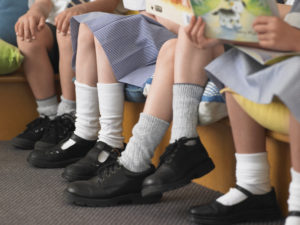GETTING IT RIGHT: WHY THE PERFECT SCHOOL SHOE IS IMPORTANT IN THE BACK TO SCHOOL RUSH
Wearing poor fitting school shoes can have a negative impact on your child’s health. Bones in children’s feet are still developing and are far more vulnerable to stresses when compared to adults. Ill-fitting shoes that are too tight, too big, too small, rub or cause injury to the feet, are likely to cause problems for bone growth and development, as well as for a child’s gait, posture and stability. While you’re getting your child prepared for the school year, don’t forget the importance of the shoes that will be carrying them around all day.
DOs
1. Ensure that shoes have ample adjustment and support in the form of buckles, shoelaces, or Velcro straps. Adequate fastenings will help to hold the shoe to the foot and allow the child to walk, run and play comfortably, without their shoes tripping them up.
2. Make sure that feet are properly measured when buying new school shoes. In most shoe stores, staff will be experienced and able to ensure that shoes fit properly in width and length. Different shoe manufactures use different sizes, so don’t assume that you know your child’s shoe size, have their feet measured properly in every shop you visit.
3. Buy shoes made from natural materials, as they’ll allow feet to breathe and reduce the build up of potentially harmful bacteria.
4. Soles should provide plenty of shock absorption to the balls of the feet and the heels to help soften the impact of running and jumping on delicate feet.
5. If your child’s feet are different lengths (this is quite common), always go up a size rather than down so as not to cramp the longer foot.
DON’Ts
1. Slip-on shoes are a big no-no. The muscles and tendons of the feet are potentially forced to work much harder to keep slip-ons, such as ballet flats, from falling off and it is also common to scrunch the toes to help keep the shoes on. This can lead to pain and serious deformities of the toes and arches, as well as long-term problems with overuse disorders, such as tendonitis.
2. Straggly edges, seams or stitching on the material inside the shoes can cause injury from constant rubbing and should be avoided. Check the inside of the shoe with your fingers to feel for any sharp or uneven edges and don’t buy shoes that aren’t smooth to touch as they will irritate your child’s feet and cause friction injuries such as blisters.
3. Don’t allow your child to wear fashion shoes such as canvas plimsolls to school everyday. While these shoes are great for occasional use, they don’t provide the support that growing feet need on a regular basis during physical activity.
4. While sports shoes are usually great in terms of support and comfort, they are also generally made to suit specific sports and aren’t intended for regular use. Save the sports shoes for sport instead of for all the time.
5. Don’t buy shoes that are too big as a way of allowing your child to grow into them throughout the year. Shoes that are too long will cause unnecessary rubbing and potential tripping hazards as the feet work harder to move comfortably in the shoes and hold them on.
6. Don’t buy shoes that are too small as they can squish the toes and prevent normal bone development.
Perfect fit guide to selecting new school shoes for your child
Shoe structure and design play a big part in the comfort, safety and health of your child’s feet, but if shoes don’t fit properly, damage will be caused no matter how well they have been made. Follow the steps below to ensure that new shoes fit your child properly for the school year.
1. Length: new shoes should be around a thumb’s width longer than your child’s longest toe. The foot slides forward inside the shoe when walking, and the thumb test is a good way to ensure that your child’s toes aren’t constantly contacting into the front of their shoes, which could cause injury.
2. Width: shoes should fit without constricting the sides of the feet or the toes. Little feet need room to move and shoes should have a wide and deep toe box to allow kids to wriggle their toes comfortably.
3. Height: heels should have a broad base and heel height should never be more than 4cm.
4. Ankle grip: the top of the shoe should fit around the ankle without rubbing.
5. Heel fit: the heel of the shoe should grip comfortably around the heel.
6. Comfort: your child should be able to walk and move naturally in the shoes without any changed behaviour or unusual walking patterns. Take time to allow this at the fitting.
If you have any trouble finding the right shoes for your child, visit our podiatrists so that they an help get you on the right track. Call us on 3820 6326 or you can book online.
